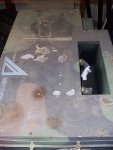Enclosed on the sides and open on the ends would be better.
With three sides closed you might get a lot of heat build up due to swirling air. Maybe wide doors that can be open when running? They could be incorporated into the plan by using them to further channel the noise away from the area you want quiet.
Another option would be to duct air through the wall and directly to the fan intake.
The walls being only a foot away might block airflow. Note that when a generator is trailer mounted the canvas ends (sides if cross mounted) are rolled up so the set is essentially in an open shed.
What your worrying about is getting a lot of cool air with no restriction to the intake. A wall a foot away at the intake end will reduce the airflow. Any restrictions to hot air exhaust will cause it to swirl around the unit and heat things more than needed.
Consider using flex exhaust hose to a pair of low restriction straight through tractor style mufflers with flappers. They could be mounted horizontally to reduce the visible signature. If horizontal, drill a few weep holes in the bottom side of the mufflers to allow condensate to drain. If verticle, put the weep holes at the lowest point of the exhaust system. The flex hose transmits less vibration (the cause of all the noise) to the outside of the shed than pipe does.
Noise attenuation is all about de-coupling surfaces and making the noise pass through materials of varying densities. Different wave-lengths of sound are reduced in intensity by different densities of material. Avoid a hard interior surface. Consider a layer of faom board or even encapsulated fiberglass insulation bats.
If using conventional framing, use a 2x6 sill and plate with 2x4 studs at 24" centers. Stagger every other stud on the opposite long edge of the plate and weave the insulation around the studs horizontally. This keeps vibration from the inner wall from vibrating the outer wall and will cut down the drumming effect of a normal wall.
At the extreme end, a flat roof or ceiling can be de-coupled by using staggered joists (rafters) and putting a one inch layer of sand over the inner ceiling before installing loose insulation and the upper sheating. All the energy expended in vibrating the sand would have come out as noise. It really knocks back noise coming through a ceiling (roof).
If you need some simple drawings, shoot me a PM. One of my construction standards book has a chapter devoted to noise attenuation. I'll mail or FAX you some drawings.
Place the open ends of the shed facing away from the area you want kept quiet.
Lance




